In urban Singapore, it always feels refreshing to be away from the bustling city life once in a while. Recently I managed to have a nice little getaway among the tropical islands. Well… Sort of. I paid a visit to Pulau Ubin for the first time in my life!

Pulau ubin is an off-shore island in the North East of Singapore, accessible only by water transport. (Yes, even for a small island city/country like ours, we do have even smaller islands surrounding us!) Our main purpose there was to visit Chek Jawa wetlands, a beach at the Eastern tip of the boomerang-shaped island. It is one of the last remaining pockets of biodiversity in land-scarce Singapore.
But since it was my maiden trip to this rustic island, I noted some interesting things about it.
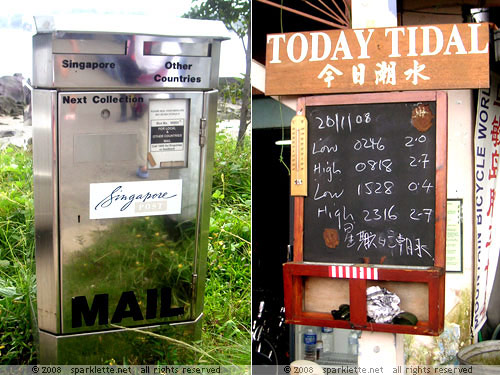
At the entry point of Pulau Ubin, I spotted a postbox! I wonder who are the people responsible for getting the mail in and out of the island, and how often? There was also a tidal information board at one of the shops. Tidal information is particularly crucial for people visiting Chek Jawa.
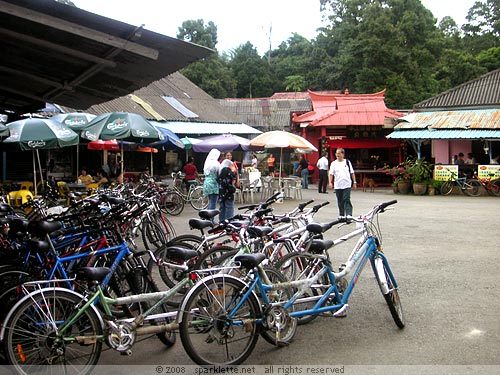
Bicycles, being the primary form of transport at Pulau Ubin, can be rented cheaply at S$2 a day. There are vans and lorries too, all having license plates prefixed with “PU”. I don’t recall seeing any car at all.

There are also many dogs living on the island. I especially like this doggy! He’s just sleeping under the hot sun on the road without a care to all the bicycles whizzing right past him!

Then he wakes up. Aww… Love the bent little paw!
On to Chek Jawa wetlands! We had to go there by van, coursing through narrow roads where tree canopies from one side of the road frequently joined those from the other. We passed by a few abandoned granite quarries along the way. This is actually how the island got its name in the first place. Pulau Ubin literally means “granite island” in Malay.
Our driver was a kindly, chatty man in his 60s. He was born and raised in pulau ubin and had been living there his entire life! Some interesting facts that he shared with us:
#1: There are only 40 plus residents on the island these days, compared to the 4000 plus only decades ago.
#2: It is very inconvenient to get to mainland Singapore. A bumboat operator would only agree to leave when there are 12 passengers, each paying a $2 fare. At times he has to wait 2 to 3 hours for more passengers to arrive, or else he has to pay the full fare of $24 if he’s the only passenger!
#3: He used to keep a wild boar as a pet! According to him, it was a very smart animal. Even when he rode away on a motorbike, the boar would find him within 10 minutes. Haha!

At Chek Jawa, we met Ron, our tour guide who’s a volunteer there. He would be bringing us (in a group of 15) around the place and introducing us to the various plants and creatures of Chek Jawa.
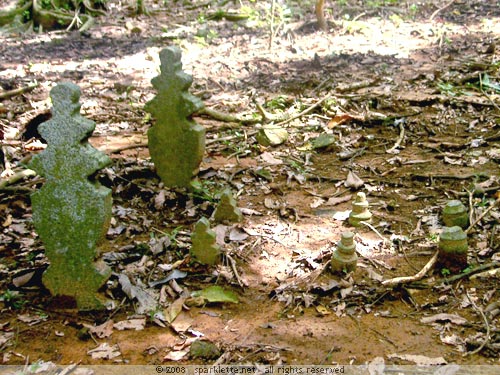
Somewhere near the entrance we saw these tombstones. Apparently, they are of a Malay family, with the two big tombstones belonging to the parents and the little ones, the children. We’re not sure why the tombstones are there, or if the entire family perished together. If anyone knows the story, let me know!

Photo by Snapz Lover
This is Jejawi Tower, a 7-storey (21 meters) tall observatory tower where a panoramic view of the Chek Jawa greenery and surrounding sea can be seen. It would hold 20 people at a time. Some people in the group remarked that it seemed to sway a little when we were at the top, although I didn’t exactly feel anything.
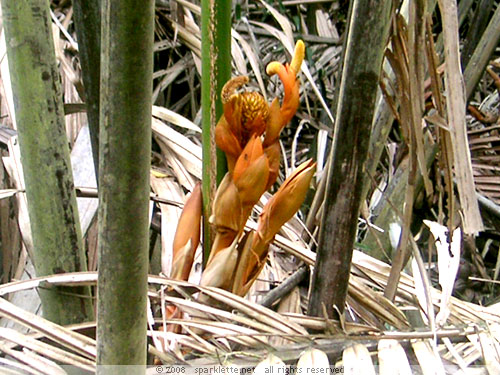
In the mangrove area, we walked through nipah palms, better known as attap palms in Singapore. Their fruits, the attap chee, are used in ice kacang (a shaved ice dessert native to Singapore and Malaysia)! We were also pretty lucky to spot one that was in bloom!

These exposed tree roots are a common sight in mangroves. Such areas are frequently flooded and with the soil lacking in oxygen, the roots have to take in oxygen from the air instead.
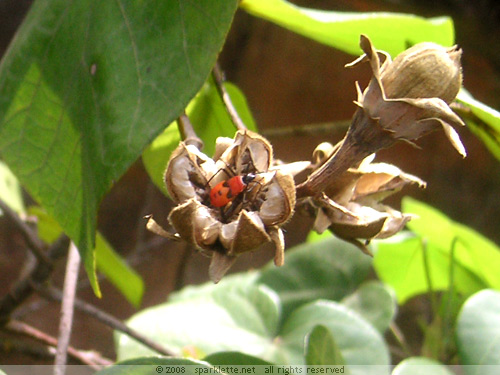
Here’s a bright red little guy feasting on the fruit of a plant.
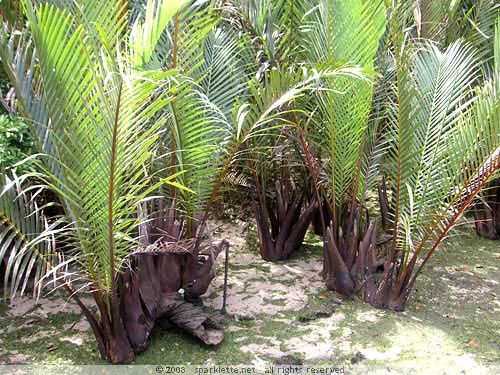
More palms! What’s interesting about these palms is that although this looks like three separate palms, it may very well be just a single one branching out into three in the soil. Things aren’t always what they seem!
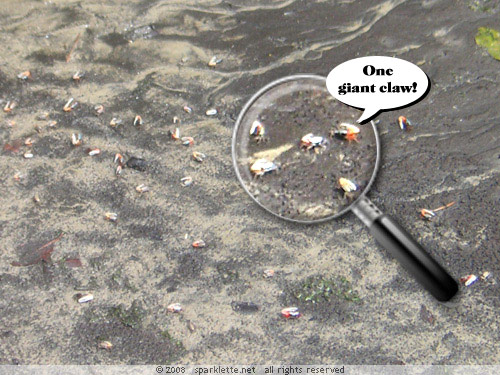
These tiny little creatures are fiddler crabs. The male crabs have one particularly huge claw that serves to attract females. In the animal kingdom, size matters! (But ironically, these crabs are so tiny!)
If you are wondering how we managed to walk through the forest and the crab kingdom that easily, it’s with the help of a 1.1 kilometre long elevated boardwalk that weaves through the forest to the intertidal area.
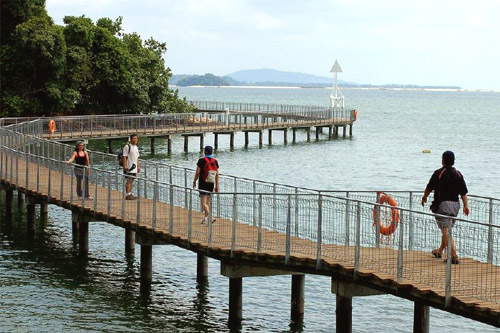
Photo by danwoo
At first glance, the boardwalk planks appear to be made from wood. But they are actually a much hardier combination of concrete and fibreglass, with simulated wood patterns engraved upon. Look closely and you would notice the wood patterns being repeated!
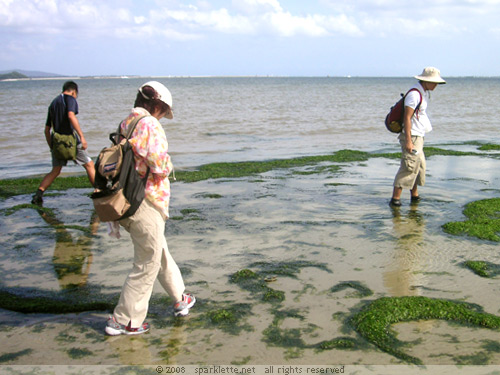
Remember that I mentioned tidal information is very important to Chek Jawa visitors? Well, at low tide, we could take a walk through the intertidal zone, which is a rich treasure trove of marine aquatic life. Ron informed us that a recent flood wiped out much of it and sadly, what we see now is just ten percent of what it was before. But there are several healthy signs of recovery, which is very encouraging.
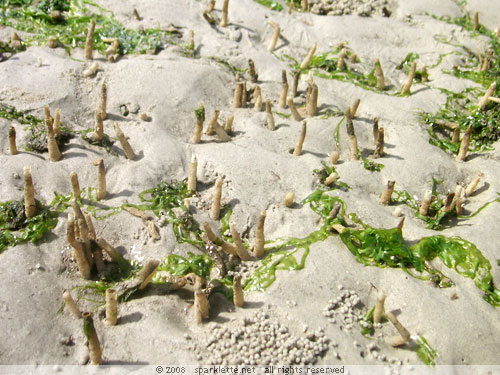
These little “cigarettes” that stick out from the sand are actually homes for tube worms! We were encouraged to walk as closely together as possible to minimise the damage we do to our tiny friends living here.
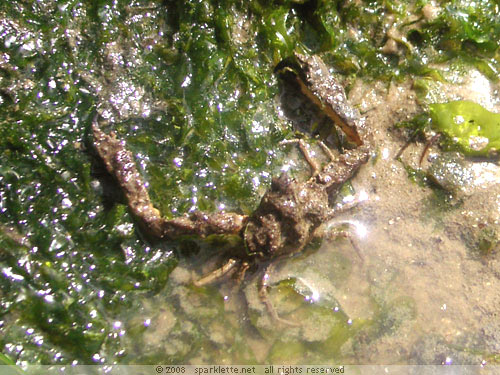
This well-camouflaged crab is an elbow crab, named for the way its claws seem to have cute little elbows.
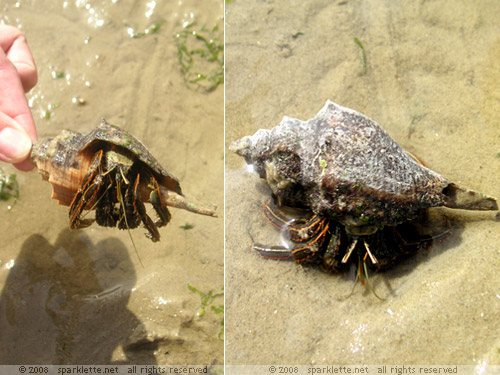
A little hermit crab has found a makeshift home in a shell! This is a reminder to us that we shouldn’t pick up so many shells from the seashores because each time we do, we are depriving these fragile little crabs of potential new homes.
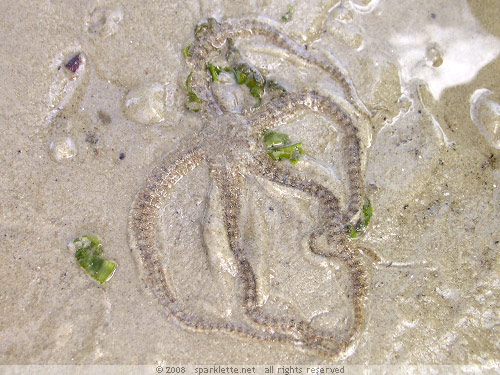
Another very fragile creature is this five-legged brittle star. As its name suggests, it can break its legs off at whim, allowing an easy escape from its predators. Just as easily, it can grow new limbs too.
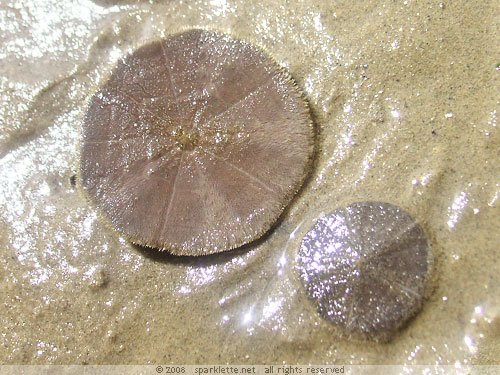
My, don’t these round and flat marine animals look unusual? They are sand dollars, a close relative of the sea urchin. They resemble coins!
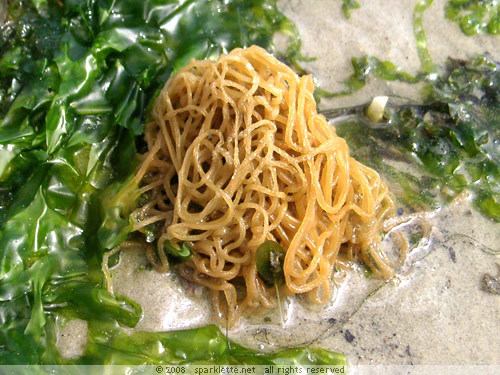
In my previous post, I had asked all of you to guess what this crumpled pile of “fried bee hoon” is. Well, I think many of you would be surprised to know that it’s the eggs of a queer-looking sea creature…
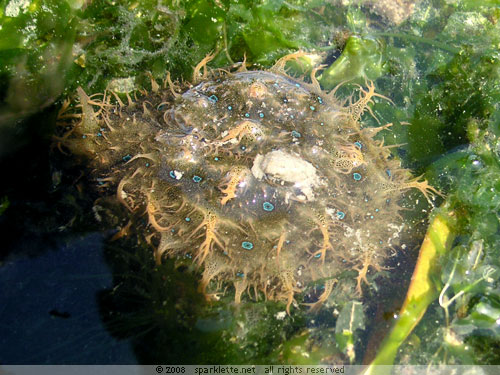
… the sea hare! Initially I had thought that our guide said “sea hair”, which would have been an appropriate name anyway given how hairy this creature is. The bright blue spots on its hairy body really stand out!

And now, for something cute, the starfish! This little guy does a great job of burrowing into the sand.
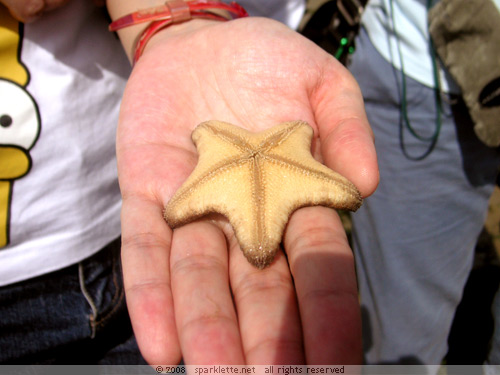
My favourite creature of the day is this puffy cake sea star. Doesn’t it resemble a star-shaped cake or cookie?

And here’s one of my favourite ingredients in pasta – mussels! When I spotted them, they were growing on concrete pillars that were exposed only at low tide.
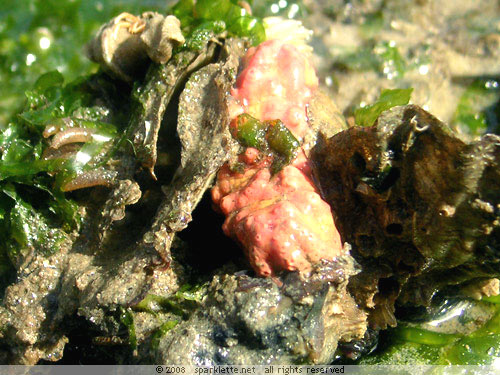
The last sea creature we saw was also the most uniquely-coloured one. It’s a sea cucumber in bright girlish pink! Waaa!
Boy, had this been an enriching and educational experience that was worth every insect bite and sunburn. I think I learned more about marine life during this 3-hour-long guided walk than I had ever learned in school!
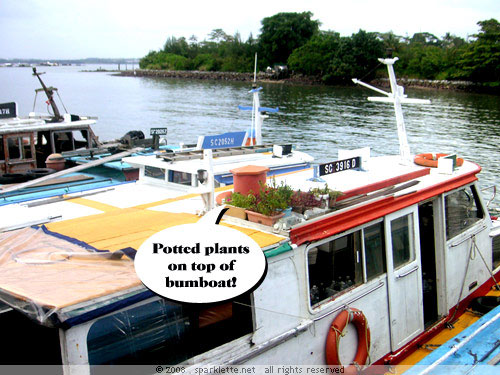
As we hopped onto a bumboat that would take us back to mainland Singapore, one particular bumboat stood out. Its owner has placed potted plants on its rooftop, as a subtle testament to how Pulau Ubin is indeed an island where its nature and greenery should be preserved.

Jan 24, 2008
3
Nice post, Veron! You’ve pointed out things that I didn’t notice about Ubin. Guess I haven’t been very observant the times I was there.
Jan 24, 2008
90
Wow… those are really nice photos. Very well done! :D Chek Jawa has changed quite a fair bit.
Michael
Jan 24, 2008
16
ah, I went chek jawa not too long ago too. I dun know why u didn’t feel it. But when I went up the tower, I thought the tower was swaying like mad. Then again, I’m height-phobic.
I thnk I missed all the interesting marine life that shows up at low tide. What a pity. The sea-hare’s a funny thing. I wonder if it bites.
Jan 24, 2008
80
That is VERY, very cool. But the sea hare eggs really gave me the shiver. Do you think noodle manufacturers will accidentally put the eggs among noodles? I don’t feel safe eating noodles now! Haha!
Jan 25, 2008
3472
acroamatic: Aww I’m sure you noticed other things that I didn’t. This calls for another visit!
Miccheng: Thanks! Didn’t realise so many people have already been to Chek Jawa too.
noah: lol many people talked about the swaying but I seriously didn’t feel it, and I wonder why! We spent quite a bit of time up there and even took several group photos.
pkchukiss: Haha I doubt there would be such a mix up. Sea hare eggs would only be found at sea right? I think they look cute, in a gross kind of way.
Jan 26, 2008
90
I see you went with a tour group. :D
The time i went, we had an unofficial tour guide – a staff from Peoples’ Association. It was high tide by the time we reach – thus we couldn’t go in.
Oh well…
Mic
Jan 28, 2008
4
Hi Veron,
I really enjoyed this post A LOT!!!! Will try to drag my friends to accompany me to Chek Jawa.
Glad to see you back in “action”.
Take care and cont. to write…write….write :D!
Jan 30, 2008
1
Very nice pictures of Chek Jawa!
Feb 28, 2008
19
I thought the eggs were cold soba! And I had thought it looked delicious too! Oh man..now it surely did spoil my appetite for soba!!! =(
Mar 3, 2008
3472
lol they sure look more like cold soba than fried bee hoon!
Jun 12, 2008
1
Wow. These pics inspires me to go Chek Jawa! Hopefully I can catch beautiful things there too!
Feb 21, 2009
1
=) wow.. i love this entry.. i went to Chek Jawa last week – you definitely took more pics
May 29, 2010
1
I went there last December too! It was an awesome experience, we got to see huge sea star, anemones and sea cucumber though I didn’t see the ‘soba’. Haha.
Yea, it’s such a pity that Chek Jawa wetland is affected by the oil spill. :(
Jun 1, 2010
3472
Hehe I still remember seeing the ‘soba‘ a few times along the wetlands. Pretty amazing! They really look like soba and bee hoon!
Just read in the papers that the oil spill at Chek Jawa has been cleaned up. Am keeping my fingers crossed that all these wonderful creatures survived.
Jun 27, 2010
2
Hi Veron,
This post of yours is really informative. I like how sharp and clear your photos are and the text descriptions that go with them.
I thought I would let you know that I would be linking one of my post on Pulau Ubin to this page of yours. BTW, it was my maiden trip too even though I’m a Singaporean.
Jun 27, 2010
3472
Hi Jolene,
I’m glad you like this post. Not many Singaporeans have visited Chek Jawa, so it is my pleasure to introduce more people to this amazing wetlands. How did you find the place? Certainly hope the oil spill didn’t affect it that much!
Jun 27, 2010
2
I love the place. It was an enriching experience and I had lots to tell my Science class the next day. =)
Sep 6, 2015
1
Love the pictures! I’m writing a post on Pulau Ubin myself but I went alone. I see that going with a guide can result in a lot of interesting knowledge. :)